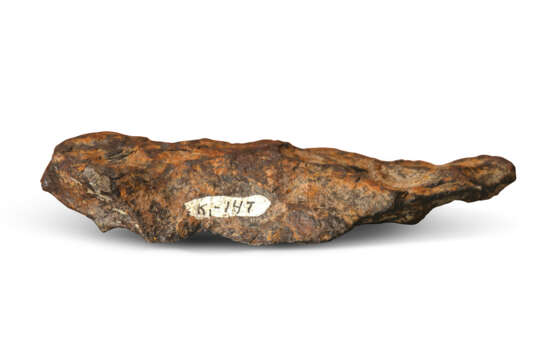ID 737493
Lot 4 | CANYON DIABLO — FROM THE BEST-PRESERVED METEORITE CRATER ON EARTH
Estimate value
£ 2 000 – 3 000
Canyon Diablos ("Canyon of the Devil") are the quintessential American meteorite, prized by museums and private collectors everywhere. Like most meteorites, this specimen originated in the asteroid belt between Mars and Jupiter. Approximately 49,000 years ago it was part of an errant asteroid that plowed into the Arizona desert with the force of more than 100 atomic bombs. Fragments were ejected more than 11 miles away from the point of impact, and the main mass vaporized, creating the world's best-preserved meteorite crater. The renowned "Meteor Crater" near Winslow, Arizona, is nearly one mile across and 600 feet deep.
At the turn of the 20th Century, businessman Daniel Barringer reasoned that this crater had to have been created by an enormous mass weighing millions of tons; and he believed this mass, worth a fortune in nickel and iron, lay under the crater's base. In 1903 Barringer filed a mining claim and commenced drilling. Although he worked for years, he did not find a large mass. Barringer later formed a public entity to assist in financing additional exploratory drilling. Still nothing. Scientists later determined that a meteorite far smaller than what Barringer believed existed would possess sufficient energy to blow a huge hole in the desert floor — as well as generate enough heat to vaporize much of its mass. In effect, the mass that Barringer spent the last decades of his life searching for did not exist — but this dense, engaging example is an exemplary find. The crater itself is an international tourist attraction not to be missed.
Christie's would like to thank Dr. Alan E. Rubin at the Department of Earth, Planetary, and Space Sciences, University of California, Los Angeles for his assistance in preparing this catalogue.
120 mm x 70 mm x 20 mm (43/4 x 23/4 x 3/4 in.)
514g.
| Address of auction |
CHRISTIE'S 8 King Street, St. James's SW1Y 6QT London United Kingdom | |
|---|---|---|
| Preview |
| |
| Phone | +44 (0)20 7839 9060 | |
| Buyer Premium | see on Website | |
| Conditions of purchase | Conditions of purchase |





